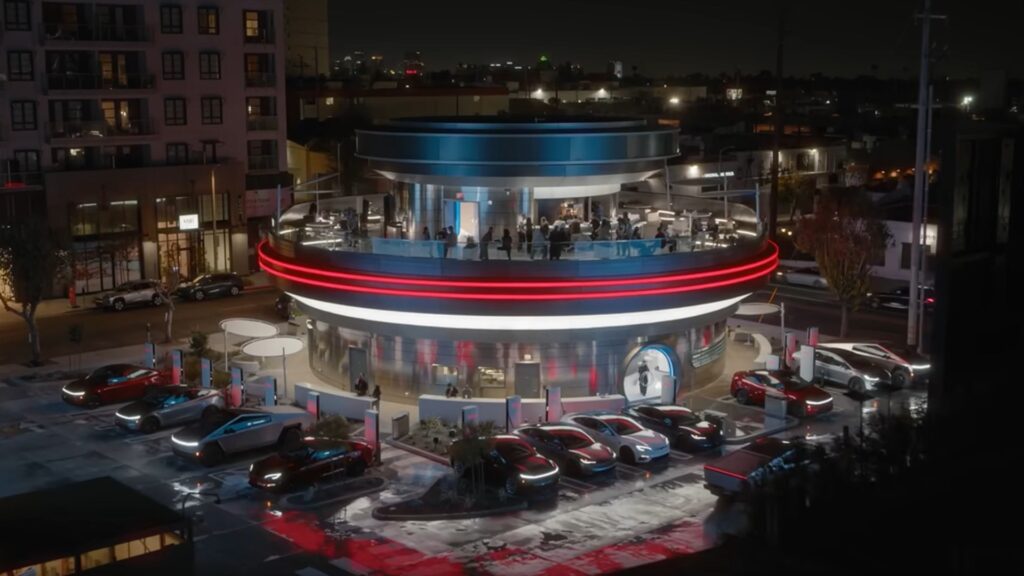Tesla, known for its innovative electric cars, has recently ventured into a new business sector with the launch of a “diner and drive-in” concept. Despite facing challenges in its core business, including declining sales and conflicts with government authorities, Tesla has introduced this new dining and retail destination on Santa Monica Boulevard.
This establishment, located where a Shakey’s restaurant previously stood, aims to provide a convenient and fast-casual dining experience for Tesla customers. Customers can place their orders from their cars and be served upon arrival, with a smart kitchen prioritizing orders based on driving distance to ensure freshness and efficiency.
While the concept of a drive-in restaurant is not new, Tesla’s approach integrates its electric vehicle charging infrastructure with a dining experience, offering a unique value proposition to its customers. This move also serves as a revenue stream for Tesla at a time when traditional car sales are becoming more challenging.
However, some critics question the relevance of this new venture to Tesla’s core business of selling electric vehicles, particularly the upcoming Cybertruck. Despite the potential success of the Tesla Diner as an attraction in Hollywood, concerns remain about its focus on revenue generation over community service and customer experience.
In a country where roadhouses and fuel stops have long been a staple of road travel, the shift towards fast chargers and dining establishments like Tesla’s Diner raises questions about the evolution of the American roadside experience. While there may be a kernel of genius in Tesla’s concept, it remains to be seen whether it can fully capture the essence of a traditional rest stop.
Overall, Tesla’s foray into the restaurant business reflects its innovative spirit and willingness to explore new opportunities beyond the automotive industry. Whether this venture will be a success and contribute significantly to Tesla’s bottom line remains to be seen, but it certainly adds an interesting chapter to the company’s diverse portfolio of offerings. Title: The Impact of Social Media on Mental Health
In today’s digital age, social media has become an integral part of our daily lives. From connecting with friends and family to staying informed about current events, social media platforms like Facebook, Instagram, and Twitter have revolutionized the way we communicate and interact with one another. However, while social media has many benefits, it also has a dark side that can negatively impact our mental health.
One of the main ways that social media can affect our mental health is through comparison. When we scroll through our feeds and see our friends and acquaintances posting about their seemingly perfect lives, it can lead to feelings of inadequacy and low self-esteem. We may start to compare our own lives to the carefully curated highlight reels of others, leading to feelings of jealousy and self-doubt.
Additionally, the constant stream of information and notifications on social media can be overwhelming and contribute to feelings of anxiety and stress. The pressure to keep up with the latest trends and maintain an online presence can be exhausting, leading to burnout and mental fatigue.
Another way that social media can impact mental health is through cyberbullying. With the anonymity that the internet provides, people feel emboldened to say hurtful and harmful things to others online. This can have devastating effects on the mental well-being of the victim, leading to feelings of isolation, depression, and even thoughts of self-harm.
On the flip side, social media can also be a source of support and connection for those struggling with mental health issues. Online communities and support groups provide a safe space for individuals to share their experiences and seek advice from others who may be going through similar struggles. Social media can also be a valuable tool for raising awareness about mental health issues and reducing the stigma surrounding mental illness.
To mitigate the negative impact of social media on mental health, it’s important to set boundaries and practice self-care. Limiting the amount of time spent on social media, unfollowing accounts that trigger negative emotions, and taking breaks when needed can help maintain a healthy relationship with technology. It’s also important to prioritize real-life connections and engage in activities that promote mental well-being, such as exercise, mindfulness, and spending time outdoors.
In conclusion, while social media has the power to connect us in ways we never thought possible, it also has the potential to harm our mental health if not used mindfully. By being aware of the impact of social media on our well-being and taking steps to protect ourselves, we can harness the positive aspects of technology while mitigating the negative effects on our mental health.

